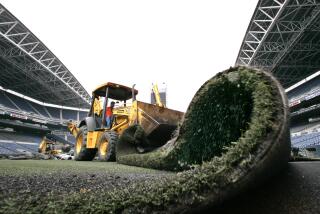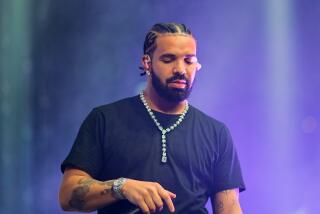Bankruptcy Has Artificial Sun Setting on AstroTurf
HOUSTON — It took the Astrodome, an air-conditioned refuge from the brutal Texas heat, to create the need for AstroTurf, an artificial grass that could survive an artificial environment. But 37 years after its professional sports debut, the ersatz turf has reached its end.
Southwest Recreational Industries Inc., the Texas company that made AstroTurf, last week filed for bankruptcy to go out of business -- citing over-expansion and a shrinking market for nylon lawns.
For a certain generation of Houstonians, the Space Age wonder helped define this city in the 1960s. Moonshots, the Astrodome and AstroTurf brought a new image to a town then known mainly for big-bellied oil tycoons.
The space-race era is “part of our history that should be valued and remembered,” said Linda Streicher, who spent much of her youth wearing orange hot pants while working at the dome as a ball girl, tour guide and “spacette” -- the futuristic term for a female usher.
“The newer people don’t appreciate it, they just want to go on to the next thing,” she said.
Ed Milner, known as Mr. AstroTurf for his role in creating the faux fields, sighed when he talked about the bankruptcy.
“You hate to see anything really well done get messed up,” said the retired chemical engineer for Monsanto Co. and former president of AstroTurf Industries. Southwest Recreational bought his firm in 1994.
The Astrodome opened in 1965, built by millionaire Roy Hofheinz so that Houston fans could enjoy professional sports in comfort. But the natural Bermuda grass tended to wilt and die inside the covered building, so chemists at Monsanto in St. Louis came to the rescue.
Their synthetic product, then called ChemGrass, had been developed as a covering to turn asphalt lots in urban areas into playgrounds for children. In adapting ChemGrass for professional sports, the scientists studied large open fields, examining the texture of the blades and the springy quality of the sod.
They tried to mimic nature, but couldn’t do much about AstroTurf’s startling green color. “We were limited ... because when you’re working with nylon, there wasn’t a huge list of pigments that would take,” Milner said.
Milner, 75, talks about the development of what was called “the magic carpet” as if it had happened yesterday.
Monsanto trademarked the AstroTurf name before Hofheinz had a chance to appropriate it for himself.
“Listen, he was a Texas wheeler-dealer from the word go,” Milner said. “He had ‘Astro’ everything -- Astroworld, Astrodome, all that stuff. We were sort of lucky we beat him to the trademark office.”
On April 18, 1966, the Houston Astros played the Los Angeles Dodgers in the first Major League Baseball game held on artificial grass. The Dodgers won, 6 to 3.
Over the years, AstroTurf was maligned for causing painful “turf burns” as well as “turf toe” and “turf knee” injuries. But Streicher, 48, remembers the good. As an Astros ball girl, she dusted off the bases during the seventh-inning stretch, ending her turn in the spotlight by kissing the umpire.
“I remember the AstroTurf was bouncy under my feet,” she said. “I liked how it felt when I ran on it.”
The Astros moved out of the dome in 1999 and into a new stadium. The Astrodome is owned by Harris County, which occasionally rolls out a worn length of AstroTurf -- stained and coming apart at the seams -- when someone rents the place out for a company baseball game.
AstroTurf may be history, Milner said, but for those who can appreciate a hardy green lawn that doesn’t require water or sun, there will always be room for its successors. There are newer generations of nylon grass that more closely resemble the real thing.
Not long ago, Milner said, artificial grass transformed the roof of a New York sewer plant into a recreation area for children.
“There’s no way in the world you could put enough dirt out there for real grass, and here’s a place where thousands of kids will play,” he said.
Natural grass and what Milner calls “the fashion for [building] retro stadiums” may be in vogue, but he is certain his life’s work will endure. “It comes down to a matter of function over fashion,” he said. “Where function demands it, artificial turf will do just fine.”
More to Read
Inside the business of entertainment
The Wide Shot brings you news, analysis and insights on everything from streaming wars to production — and what it all means for the future.
You may occasionally receive promotional content from the Los Angeles Times.










